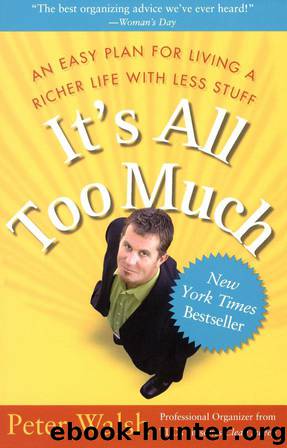It's All Too Much: An Easy Plan for Living a Richer Life With Less Stuff by Walsh Peter

Author:Walsh, Peter [Walsh, Peter]
Language: eng
Format: epub
Tags: Non-Fiction, Self Help, Reference, Adult, Psychology, Business
ISBN: 9780743292658
Amazon: 0743292650
Barnesnoble: 0743292650
Goodreads: 34266
Publisher: Free Press
Published: 2007-11-06T07:00:00+00:00
LESSONS LEARNED FROM TOY LIMITS
Setting limits teaches the child:
you can’t own everything.
there is joy and satisfaction in giving to others who are less fortunate.
Mom and Dad (or the grandparents) are not a bottomless pit of supply.
you must make decisions surrounding the things you own.
you must decide what is important to you, value it, and look after it.
This may seem harsh, but children really do not need an endless supply of things to be happy. And it is a parent’s obligation to help the child create a world in which solid values come before the acquisition of the latest video game or newest gadget. This investment when the child is young will yield huge dividends later on in life.
Outgrown toys
Kids outgrow everything quickly, including their interest in toys. It’s important to regularly sort toys with your kids, to discard and pass on everything that they have outgrown, that they no longer play with, or that is damaged. Don’t do this on your own. Involve the kids in deciding what should stay and what should go.
Arrange the toys in distinct piles—either by type of toy, by age appropriateness, or by length of time the child has had the toy. This will help your children see the toys as distinct groups and make the task more manageable. Agree on the volume of toys that is reasonable to keep, factoring in the size of the space, then work together to that goal.
Be patient—learning to part with the things that have memories can be tough. Don’t we all know it! It always helps to schedule this purge right before a birthday or the holidays when kids are looking forward to some new toys.
Toy routines
Just as limits are important in helping kids manage clutter, so are simple routines. In addition to owning a reasonable, manageable quantity of toys, children need to learn the regular rhythm of picking up after themselves. At the end of the play session or at the end of the day, the toys need to be returned to their bins. If this seems unreasonable, go back to the vision you have for the life you want. If you want a lifetime of picking up after your children, this is where it starts. Your choice!
Download
This site does not store any files on its server. We only index and link to content provided by other sites. Please contact the content providers to delete copyright contents if any and email us, we'll remove relevant links or contents immediately.
The Body: A Guide for Occupants by Bill Bryson(4974)
Audition by Ryu Murakami(4850)
Adulting by Kelly Williams Brown(4487)
Housekeeping by Marilynne Robinson(4347)
Be in a Treehouse by Pete Nelson(3948)
Zero Waste Home by Bea Johnson(3780)
Seriously... I'm Kidding by Ellen DeGeneres(3577)
Better Homes and Gardens New Cookbook by Better Homes & Gardens(3525)
The Healing Self by Deepak Chopra(3474)
Barkskins by Annie Proulx(3313)
Hedgerow by John Wright(3276)
The Cellar by Natasha Preston(3262)
Spark Joy by Marie Kondo(3249)
The Genius of Japanese Carpentry by Azby Brown(3224)
The Life-Changing Magic Of Tidying Up- The Japanese Art Of Decluttering And Organizing (v5.0) by Marie Kondo(3213)
120 Days of Sodom by Marquis de Sade(3182)
Work Clean by Dan Charnas(3048)
The Book of Numbers by Peter Bentley(2912)
A Monk's Guide to a Clean House and Mind by Shoukei Matsumoto(2868)
